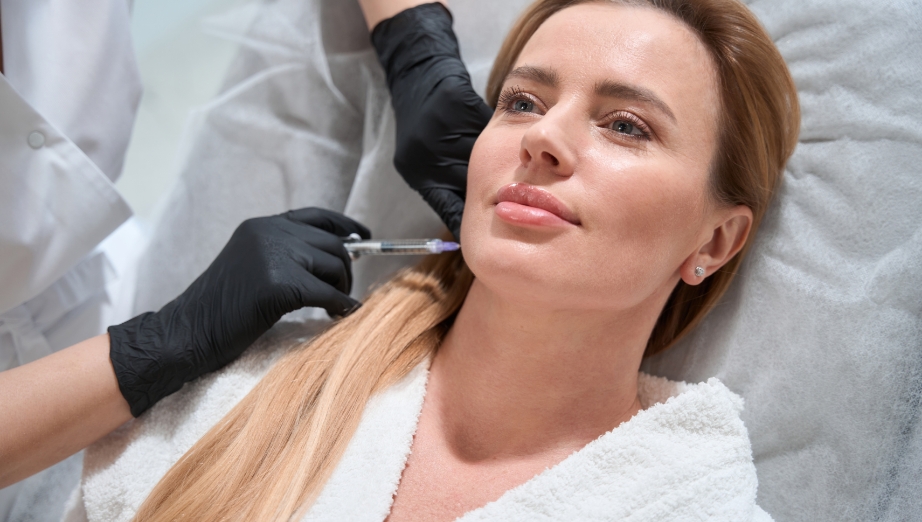Understanding Skin Structure and Volume
Facial structure and skin quality are shaped by an intricate balance of bone, muscle, fat, and skin. Each layer plays a unique role in maintaining contour, definition, and elasticity. Over time, both internal and external factors influence how these layers interact, leading to visible changes in the skin’s texture and support.
A Consultation for Skin Quality & Volume provides the opportunity to explore these biological processes in detail.This consultation focuses on education and clinical assessment, helping you understand how the skin’s natural architecture evolves with age, and how professional care can support long-term skin health within a safe, medically supervised framework.
The Science Behind Volume and Elasticity
As we age, the body’s production of collagen, elastin, and hyaluronic compounds, the structural proteins responsible for firmness and hydration, gradually declines.
This process, combined with changes to underlying bone and fat compartments, contributes to differences in contour, softness, and tone.
Your clinician will explain how several processes work together over time:
Collagen decline: Collagen provides tensile strength. After our mid-20s, its production slows by around 1% each year, leading to gradual thinning of the dermis.
Elastin changes: Elastin fibres give skin flexibility and resilience. Once damaged by UV or oxidative stress, they regenerate very slowly.
Hyaluronic compound reduction: Naturally occurring molecules that retain water within the skin decrease, contributing to dryness and loss of plumpness.
Bone resorption: The facial skeleton subtly remodels with age, altering support for overlying soft tissue.
Fat redistribution: Facial fat pads descend or shrink, affecting shape and symmetry.
Muscle dynamics: Repetitive movements and expressions can influence the way the skin drapes over time.
Together, these changes can influence how the skin reflects light, how contours appear, and how firm or hydrated the face looks and feels.

Lifestyle and Environmental Influences
Your clinician will also discuss how daily habits and environmental exposure contribute to long-term skin quality and structure:
Sun exposure: Ultraviolet radiation accelerates collagen breakdown and causes uneven pigmentation.
Nutrition: Diets lacking in protein, vitamin C, or essential fatty acids may compromise tissue repair.
Sleep and hydration: Inadequate rest or dehydration can affect circulation and elasticity.
Smoking and alcohol: Both reduce oxygen flow and contribute to oxidative stress, impairing the skin’s repair capacity.
Stress: Chronic stress hormones like cortisol can slow collagen synthesis and increase inflammation.
Understanding these influences helps you build a realistic and sustainable approach to maintaining healthy, resilient skin.
Your Consultation at Shellharbour Skin
Your consultation is a detailed, discussion-based appointment focused on your anatomy, health, and goals.It is designed to educate, assess suitability, and ensure any subsequent care is clinically justified.
During this appointment, your clinician will:
- Assess facial structure, volume distribution, and skin texture.
- Review your health history, medications, allergies, and lifestyle factors.
- Discuss your goals and expectations.
- Explore non-surgical, evidence-informed options to support structural balance and skin health.
- Explain preparation, recovery, and aftercare considerations.
- Ensure that any recommendations are medically appropriate and consented to before proceeding.
No procedure is performed without a comprehensive clinical assessment and informed-consent discussion.
Approach Discussions
Following your assessment, your clinician may outline educational pathways and clinical options suited to your needs.
These discussions are intended to deepen your understanding of your skin’s biology and to support safe, gradual, and realistic care planning.
Topics may include:
- Observation and review, where no immediate intervention is required but progress is monitored over time.
- Skin-care and home management, including topical antioxidants, hydration strategies, and barrier repair.
- Professional treatments that may stimulate or support the skin’s natural functions — such as light-based therapy, ultrasound (e.g., Ultraformer MPT – HIFU), or fractional resurfacing (e.g., Alma Hybrid CO₂).
- Medical approaches, where clinically indicated following a medical assessment — these may include the use of prescription-only substances designed to interact with the skin’s deeper layers.
- These options are discussed only in consultation with an authorised prescriber and never advertised or named on this website.
- Collaborative or referred care, when additional medical input is beneficial.
Your clinician will explain the rationale for any approach, potential risks and downtime, and relevant aftercare instructions.
After-Consultation Considerations
If a treatment plan is discussed, you’ll receive detailed written guidance covering:
- Expected recovery timelines and review appointments.
- Temporary effects such as mild swelling, redness, or tenderness.
- Safe use of skincare, sun protection, and activity modification.
- Signs to monitor and when to contact the clinic for follow-up.
You are encouraged to take time to review this information before making any decision.
Risks and Precautions
All aesthetic procedures carry potential risks.
Common temporary effects may include redness, bruising, or swelling.
Less common risks can include infection, tenderness, or asymmetry.
These are discussed thoroughly during consultation to ensure informed consent.
Cost and Planning
Consultation fees vary depending on time and complexity. Any further treatment planning or cost estimates are discussed only after your consultation and once clinical suitability is determined.
Written cost information and follow-up plans are provided before any procedure proceeds.
Important Information
- Shellharbour Skin discusses specific options only within consultation.
- We do not advertise or name prescription-only medicines
- All services are provided following a clinical assessment and informed-consent process.
- Experiences and recovery vary between individuals.
- Services are intended for adults aged 18 years and over.
- This content is for educational purposes only and does not replace professional medical advice.
Consultations and treatments at Shellharbour Skin are provided by a multidisciplinary clinical team:
Dermal Clinicians – qualified professionals who are not registered under AHPRA but hold tertiary qualifications in dermal science or dermal therapies. They perform skin treatments and consultations within their scope of practice and under clinical supervision.
Registered Nurses – AHPRA-registered health practitioners who provide skin and aesthetic treatments within their training and scope of practice.
Medical Practitioners – AHPRA-registered doctors experienced in skin health and aesthetic medicine who oversee and support all clinical services.
When clinically appropriate, a medical practitioner may prescribe or perform medical treatments following in-person assessment and in accordance with professional and legal standards.
All care is delivered in a medically supervised environment, ensuring patient safety, suitability, and adherence to evidence-based standards. You can verify registration for medical practitioners and nurses at ahpra.gov.au
Frequently Asked Questions
At what age does skin volume start to change?
Collagen production begins to decline from around the mid-20s, reducing by approximately 1% per year. While the exact timeline varies between individuals, lifestyle habits, genetics, and sun exposure can all influence how quickly visible changes appear. A consultation provides a personalised assessment based on your unique skin biology rather than age alone.
Can lifestyle habits improve skin quality?
Yes. Healthy skin is supported by consistent sun protection, balanced nutrition, hydration, and sufficient rest. Avoiding smoking, moderating alcohol intake, and managing stress also help protect collagen integrity and maintain a resilient skin barrier over time.
What are the potential risks of treatments that target skin quality and volume?
All aesthetic and medical procedures carry some risk. Common temporary effects may include redness, swelling, or mild tenderness. Less common risks can include bruising, infection, or localised irritation.Your clinician will discuss these in detail before any treatment, ensuring full understanding and informed consent.
What affects skin texture and elasticity?
Skin elasticity depends on the quality of collagen and elastin fibres within the dermis.
These fibres can be weakened by UV exposure, oxidative stress, smoking, poor sleep, or dehydration, reducing the skin’s ability to rebound and remain smooth.
Your clinician can help you understand which factors are contributing most to your current skin condition.
If you have a question, get in touch and one of our staff will be in touch shortly.




